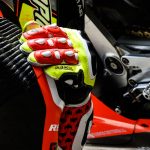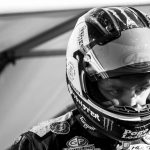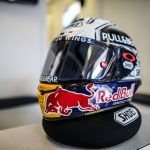It’s hard to dislike Marc Marquez. Something of a wonder on two wheels and obviously enamoured with motorcycling to the point where his considerable skill-set, balance, co-ordination and judgement make him a formidable rider in most disciplines at speed, the ? year old is also an open and jovial character: someone who laughs easily, finds it hard to turn away or hide from fans (we’ve seen him stop many times in the paddock) and is humble enough to poke fun at himself; just look at the tumble on the podium in Catalunya after his pitlane fall the same morning or bizarre YouTube dancing and singing videos while on promotion duty in Asia.
Marquez’s presence and accessibility is an enormous asset for MotoGP despite the fact that he only has statistics and records to aim for with his career (or another challenge like drastically changing manufacturers). The theme of ‘what will happen when Rossi retires?’ hangs close to the sport like a slowly approaching black cloud but Marquez is that ray of light breaking through all the time. He might not carry the same empiricism as the Italian and it will be startling to imagine the #93 still circling Grand Prix tracks for another fifteen years but there is little doubt that the Repsol man is the most watchable athlete in MotoGP and neutral fans and admirers can only hope that spectacular edge to his riding does not erode.
Around a large table in the HRC hospitality Marc confidently addresses a range of questions from five journalists and endearingly smiles, concurs and laughs talking in his native Catalan tongue. Normally time is tight, demand is huge so to gain audience with the reigning number one and routine conqueror of Austin is a rare opportunity…

On not fronting the championship yet and the start of 2017…
It’s not really what you hope for, and you always want more – or have that enthusiasm and motivation to reach for more. We didn’t have the best start for various reasons but the rhythm is there. I’m an optimist and I think I always will be, but there are some problems you can work to fix and others that you cannot. The bike is not as good as we’d like but we can work on a couple of things and I can also work when it comes to my riding style. At the end of it all we’re dependent on the tyres, and the feeling with the front – especially – marks the results of every Grand Prix.
On people talking more about the tyres in the second year compared to the first…
It’s true, but the way I see it is that last year Michelin came in ‘new’ with a tyre as a base to work through the whole season. It was good enough even though there were times when riders were crashing and didn’t really know why. It was a symmetric tyre – so the same compound on the right and left. This year Michelin, who are very ambitious and want to do the best job possible, always bring asymmetrics with two compounds so you have to get to know and work out the tyres and the six different options because you have three choices, just speaking about the front because the rear is pretty good. We only had these tyres at three races in 2016: Germany, Australia and Malaysia where it tends to be cold and therefore they’d bring some benefit. At somewhere like Catalunya, where it could be thirty degrees, there is no need to bring an asymmetric. Quite a few riders are complaining because they are not getting the stability from the tyre. I think Michelin wanted to offer something better to the riders but ended up ‘blocked’. It all works in a circle because if you have good drive and don’t need to depend on the front so much – which is not our case – then you are looking at a different area of the bike. We need to make up time with the front.
On the lottery aspect of the tyres…
Yamaha had their [bad] ‘moment’ at Jerez but we’ve had a few now! It’s pretty complicated. I won in Austin but it was not by much and also because Maverick crashed. My front tyre was destroyed at the end of that race. You can only count on a certain type of tyre so it is about compromise and you have to adapt the bike to the tyres that are the same for everyone.
On being a five year veteran of MotoGP and tackling home events like Catalunya…
Experience makes you treat the race the same as any other. When you are younger you always have that enthusiasm and nerves at the prospect of riding at home but you soon learn to treat it as ‘normal’. Of course you have the friends, fan club and you notice more red colours and 93 than usual. Racing at Catalunya now still brings quite a strange feeling, perhaps because you remember being in the stands at 10-12 years old watching the bikes. I was there watching Valentino Rossi, Dani Pedrosa and Jorge Lorenzo racing. So to be out there…I don’t know: it feels pretty great.

On ever wondering about his life and seeing it from an external perspective…
Well, it is a life dedicated to bikes. I wouldn’t change it for the world. Perhaps you lose out on other things but you win in others and it is something I was dreaming about when I was small. I’m enjoying life.
On explaining to a normal rider how the limits can be found on some circuits compared to others…
I think it is riding style and the way the corners flow as well as the grip level of various asphalt. Above all it is the mix of the corners and your style. Austin is a good circuit for me with the Honda and Dani has also been quick there also. If you go to Mugello then it is a good circuit for the Ducati. So it has to do with how the bike fits and what the bike wants to do and the configuration you can make. It is tricky to explain because at the end of the day it is a strip of asphalt with corners and you have to go quickly! It’s about styles of the bikes.
On the state and future of the Barcelona-Catalunya circuit…
There are riders who complain a lot but in the end the circuit hasn’t changed that much; it is only two corners. The entry to the stadium is quite OK but the chicane cuts the speed that you build and carry throughout the lap…but I like different things and we cannot forget that the change has been made for safety. We have to adapt. In the end we can only give our opinion but I think they need to alter the curve or make a better chicane and these are the two proposals. They could take down part of the stand to push the wall back or make it go slightly under the stand like in Holland. If they want to make a chicane then it should well done with the right inclination. The asphalt in general is practically ‘done’ and all the Formula One testing leaves it pretty marked in terms of bumps and grip.
On his fondness for motocross…
One of the main reasons is the difference you find at the track. One day it can be bumpy and another day worse or better. I like that you have to improvise on the bike and it is something you can use to improve [yourself] on the road race track. I’ve done motocross since I was small and it all comes down to the rider. OK, you have to work with suspension, but the rider makes the difference.
On whether there was a moment to choose…
Yes…and I wanted to be a motocrosser. I was nine a team made an approach for the asphalt with bills paid – the Rojas Brothers team from Mataro – and they supported me and started my career. We were really grateful and because everything was being paid my Dad said: ‘boy, off to road racing you go…’
On whether he ever thought about an alternative life as a motocrosser…
Not really because you become involved in another world and it’s still bikes. If you get yourself organised then you can still do quite a lot of motocross and a race now and then. I think I took a good path.
On still needing to ride the sand…
It’s been difficult to find the tracks in Spain but last year I stayed behind after Assen…I also cannot really take any risks. I’d love to try and will start one of these winters with something similar in Spain. I know it is great physical training so I’m keen.
On having a better level than his brother…
I started earlier and never really left it and he didn’t do so much. I think what you pick up as a kid never really leaves you. But he’s improving a lot, especially with his arm strength and positioning and if we’re not careful he’d quickly be at the same level.
On having any pressure with a ex-Spanish MX Champion as training partner?
Ha! That’s one of the reasons [to go well]. I’ve been training a lot with Jose [Luis Martinez] since 2013 and even more since 2014 and it works for me having a guy that pushes. It’s not the same as training alone and where you fall into a comfort zone. Having a fast guy there is like sparring, and he gives me confidence and stability because he used to race as well and knows what a rider needs. Unless you have been there – even if you are a great person – then you never really quite know.
Photos by CormacGP








